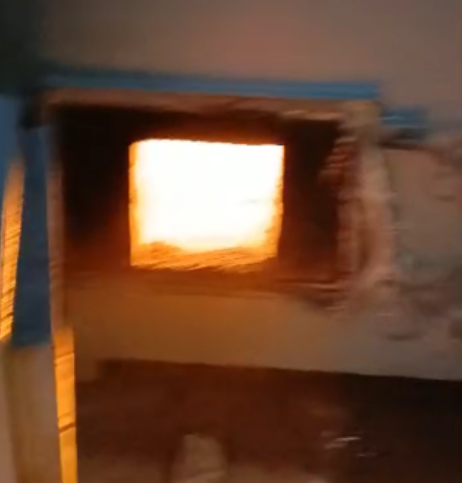The Role of Secondary Combustion Chambers in Medical Waste Incineration: Technical Rationale and Effectiveness
Medical waste presents one of the most significant challenges in modern waste management due to its infectious, pathological, and pharmaceutical content. Proper destruction is not only critical to preventing the spread of disease but also to ensuring compliance with global environmental standards. A key feature of modern medical waste incinerators, including HICLOVER’s dual-chamber models, is the integration of a secondary combustion chamber (afterburner) designed to achieve complete destruction of hazardous emissions.
Why Secondary Combustion is Essential
-
Incomplete Combustion in Primary Chambers
-
In the primary chamber, waste is ignited at temperatures between 800–1000°C, breaking down organic matter into gases and residues.
-
However, without further treatment, these gases may contain volatile organic compounds (VOCs), carbon monoxide (CO), particulates, and precursors of dioxins and furans.
-
-
Secondary Chamber Function
-
The secondary chamber introduces additional oxygen and high temperature (1000–1300°C) conditions.
-
It ensures that the gases undergo complete oxidation, converting harmful byproducts into safer compounds such as CO₂ and H₂O.
-
-
Extended Gas Retention Time
-
International guidelines, including the EU Waste Incineration Directive (2000/76/EC) and WHO recommendations, require that gases remain in the secondary chamber for at least 2 seconds at >1100°C in the presence of adequate oxygen.
-
This retention time is critical for breaking down dioxins, furans, and persistent organic pollutants (POPs).
-
Technical Rationale and Benefits
-
Dioxin and Furan Reduction
-
Dioxins are highly toxic compounds formed during incomplete combustion at lower temperatures.
-
By maintaining stable, high-temperature combustion, the secondary chamber destroys these compounds before they can condense in the flue gas.
-
-
Enhanced Pathogen Destruction
-
High-temperature secondary combustion ensures the elimination of pathogens, spores, and viruses that could survive partial burning.
-
This is particularly important in medical waste streams containing contaminated sharps, laboratory cultures, or blood products.
-
-
Compliance with Global Standards
-
Secondary combustion makes it possible for incinerators to meet strict emission limits:
-
Particulate matter (≤10–20 mg/m³)
-
Carbon monoxide ≤50 mg/m³
-
Dioxins ≤0.1 ng TEQ/m³ (EU and Chinese standards)
-
-
These values are only achievable through dual-chamber systems with controlled air supply.
-
-
Improved Fuel Efficiency
-
Secondary chambers in modern systems, such as HICLOVER PLC-controlled incinerators, use intelligent fuel-saving technology. Burners operate automatically to maintain the required temperature while minimizing fuel consumption.
-
-
Adaptability for Different Waste Streams
-
Whether the waste is infectious hospital waste, pharmaceutical residues, or pathological materials, the secondary chamber stabilizes combustion, ensuring consistent performance across varying waste loads.
-
HICLOVER’s Dual-Chamber Technology
-
TS30 PLC (35 kg/hr) – Designed for small clinics and rural hospitals where controlled dual-chamber combustion ensures safe local disposal of limited biomedical waste.
-
TS200 PLC (180 kg/hr) – Equipped with a 1.98 m³ primary chamber and 0.8 m³ secondary chamber, this model meets WHO specifications for district and regional hospitals.
-
TS300 PLC (220 kg/hr) – With an enlarged 2.4 m³ primary chamber and 1.0 m³ secondary chamber, it is suited for large hospitals and UN/NGO projects requiring donor-funded, internationally compliant systems.
Each model integrates PLC automation, Italy-brand burners, temperature monitoring with corundum probe thermometers, and >2-second gas retention, aligning with EU, CE, and ISO9001:2015 certifications.
Conclusion
The use of a secondary combustion chamber in medical waste incinerators is not optional—it is a technical necessity for modern healthcare systems. By ensuring complete destruction of hazardous emissions, secondary combustion chambers:
-
Protect public health,
-
Safeguard the environment,
-
Enable compliance with international donor and government procurement standards.
For healthcare facilities in Africa, Asia, and beyond, the adoption of HICLOVER dual-chamber incinerators such as the TS200 PLC and TS300 PLC represents a future-proof solution to safe and sustainable medical waste management.
For specifications and procurement inquiries, visit www.hiclover.com or contact sales@hiclover.com.
HICLOVER is growing brand for environmental protection field, and market share with most of Africa, Middle East, Southeast Asia countries and part of North America, Europe territory. We are trusted partner for governmental organizations, non-profit organizations, international contractors, logistics organizations, military, pet cremation business owners, etc. We have export experience more than 40 countries, including war zone like Iraq, Afghanistan, Somalia, South Sudan. Mobile: +86-13813931455(WhatsApp) Website: www.hiclover.com Email: sales@hiclover.com Email: hicloversales@gmail.com

